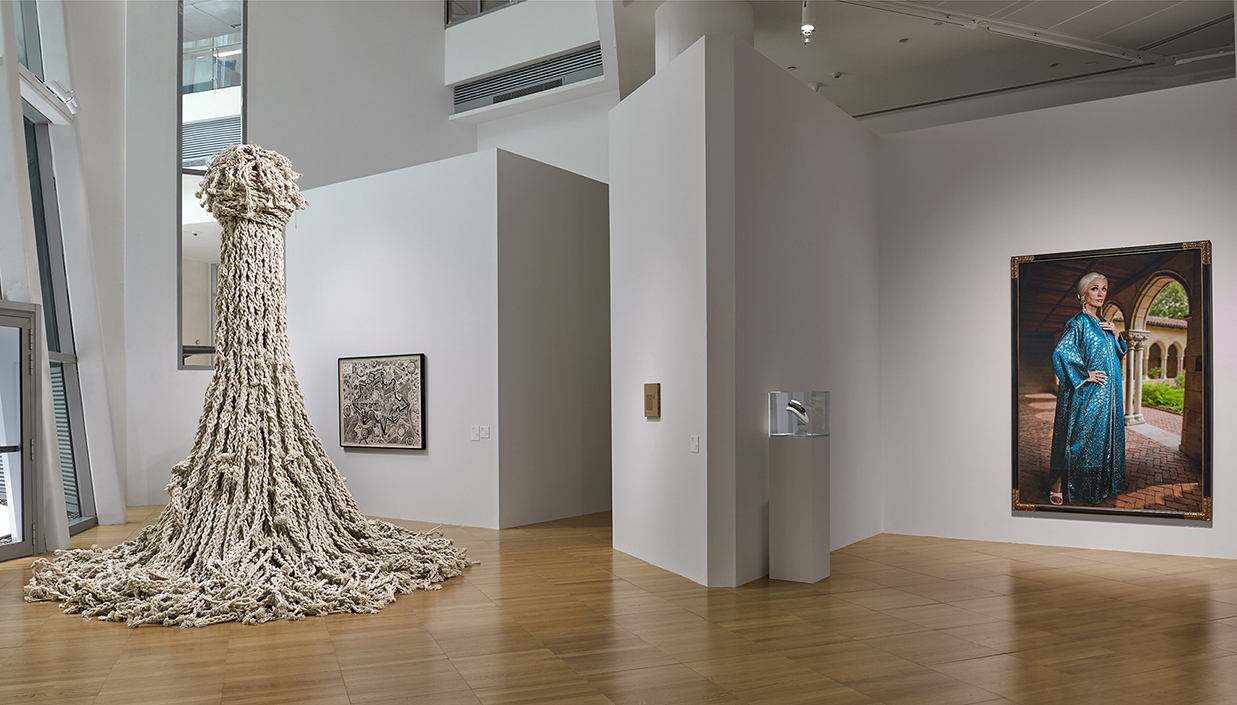“Ways of Seeing”
By Maria Mumtaz

Installation view of "Ways of Seeing" at New York University Abu Dhabi Art Gallery, 2018. Courtesy New York University Abu Dhabi Art Gallery.
Curated by Sam Bardaouil and Till Fellrath, the exhibition “Ways of Seeing” took John Berger’s 1972 television series and seminal book of the same title as its starting point. In his work, Berger dissects the ways in which an image’s meanings are constructed. He homes in on, among other topics, patriarchal hegemony, as embodied in the female nude and the depiction of the “other” in European pre-Modern painting; and the rigid, hierarchical class systems of the West. In all of Berger’s arguments, the act of looking at an artwork is always political and shaped by the processes of the image’s circulation, as well as the context of its consumption. Berger’s ideas were deeply influenced by the advent of the camera and the reproducible image, as explored by Walter Benjamin in his essay The Work of Art in the Age of Mechanical Reproduction (1936), written at a time of radical cultural transformation. By extrapolating from these ideas, Bardaouil and Fellrath aimed to examine the changes unfolding in the United Arab Emirates, and to provoke critical reflections—through the viewing of artworks—on the country’s shifting societal relations.
The exhibition at New York University Abu Dhabi Art Gallery marked the third edition of the show. The first iteration at Arter in Istanbul addressed questions of nationalism while the second version at Villa Empain in Brussels looked at Belgium’s colonial presence in Africa. Among the 41 works by 26 artists at NYUAD were additions specific to the UAE, including Lateefa bint Maktoum’s photograph Observers of Change 4 (2011), which depicts a man in Emirati garb looking at the rise of urban buildings across a rocky bay. Observing the man observe his surroundings, viewers realize they themselves are at the center of the negotiation between modernization and tradition. Similarly provoking self-reflexive gazes were Andreas Gursky’s digitally manipulated photographs of Dubai’s The World Islands—an artificial archipelago of resorts built in the shape of the world map that failed to get off the ground following the 2008 economic crisis—which challenge the supposed objectivity of photographs, while eminent UAE artist Hassan Sharif’s installation Knots (2012–16) suggests new ways to encounter everyday objects.

The show’s most poignant adaptation of Berger’s ideas, however, was in its examination of the overlooked, feminist aspects of art history. Frédéric Borgella’s The Water Carrier (undated) illustrates a woman dressed in intricately detailed clothing. She holds a bronze vase on her head with one arm while the other rests elegantly on her waist. Borgella is associated with the Orientalist genre, and his painting presents a distorted, colonial view of people from the Asian continent. The idealized subject submits to the constructs of the Orientalist male gaze. In the show, the work served as a counterpoint to the female-centric narratives that otherwise underpinned the curatorial framework. Ironically mirroring the Borgella canvas was a self-portrait by Cindy Sherman who stood similarly with her hand on her hip in elegant clothes. Sherman’s image deliberately appropriates the visual cues denoting traditional femininity and beauty to critique the representation of women in mass media. In her sculpture Hair Necklace (wood) (2013), Mona Hatoum elevates what is normally considered undesirable—body hair—by balling her own hair into pearls, thus also challenging what is considered beauty.
Another work that took on how the patriarchy has shaped the way in which we view women was Shana Moulton’s video, Mind Place Thought Stream (2014), which stars the artist’s alter ego Cynthia as she navigates fantastical environments, loosely evoking domestic spaces, that glitch out and degrade, sparking a sense of anxiety. At first glance, Ghada Amer’s Glimpse Into a New Painting (2018) is an abstract mass of threads permeating a canvas. Only upon careful study do images of six women emerge from the surface as they look down with a serene gaze on their face.
By focusing on the Orientalist gaze of the Western male and presenting it in the context of the UAE, the exhibition demanded a double act of looking. One left the exhibition wondering to what degree the images might reinforce stereotypes, and who might see through the façade.
“Ways of Seeing” is on view at the New York University Abu Dhabi Art Gallery until January 5, 2019.







